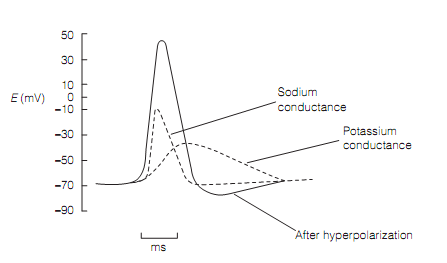Voltage-dependent potassium channels
The Excitable cells have a wide variety of various kinds of voltage-dependent potassium channel (Kv), all with their own properties. One type, the delayed outward rectifier is included in the repolarization phase of the action potential. Such channels are transmembrane glycoproteins with a molecular structure associated to that of voltage dependent sodium channels. Similar to them, they are opened by depolarization. This permits potassium ions to flow down their electrochemical gradient out of the cell. The inside of the neuron becomes very less positive, which is, it repolarizes. This accounts for the downstroke of the spike of the action potential.
At the bottom of the downstroke mainly the Navs are inactivated therefore there is no flow of sodium in the cell. Delayed outward rectifying Kvs either do not inactivate or inactivate too much slowly than Navs (based on channel type) so instantly after the spike the neuron remains highly permeable to K+ while being impermeable to Na+. The significance is that for a few milliseconds after the spike, the potassium ions continue to leave the cell carrying the membrane potential more negative than Vm. That is the after-hyperpolarization phase of the action potential. It accounts for relative refractory period, as during this time, for a stimulus to excite the cell to threshold it should make the neuron depolarize from a more inside-negative state. Lastly the membrane potential returns to the resting potential as the potassium channels flip into their closed or inactivated state in a time-dependent fashion. The modifications in ion conductance throughout the action potential are summarized as shown in figure.

Figure: Changes in ion conductance throughout the action potential.
Some of the points are as shown below:
- The size of the after-hyperpolarization is determined by the potassium equilibrium potential (EK). Whenver the K+ efflux is enough to bring the membrane potential to EK the ionic driving force on the potassium ions will be zero. None of the K+ will leave.
- As depolarization of the neuron to threshold causes the opening of Navs (permitting Na+ in) and opening of Kvs (permitting K+ out) how does an action potential occur?
The reason is that the sodium channels answer to the depolarization former than the potassium channels (therefore the name delayed) and hence the increase in sodium permeability precedes the increase in the potassium permeability.